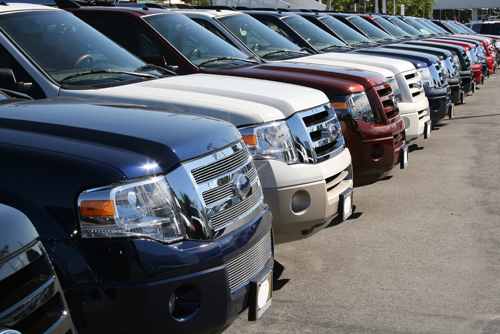CarMax Enjoys Healthy Gains in 2Q Net Income, Total Used Unit Sales

RICHMOND, Va. -
Sizable increases during the second quarter of their fiscal year in net income, comparable store used unit sales and total used unit sales left CarMax executives in an upbeat mood when they shared their latest financial statement Wednesday.
The company revealed net income increased to $107.9 million, or $0.48 per diluted share, compared with $103.0 million, or $0.46 per diluted share, earned in the second quarter of fiscal 2010.
CarMax indicated net sales and operating revenues increased 13 percent to $2.34 billion from $2.08 billion in the second quarter of last year.
Furthermore, the company’s comparable store used unit sales increased 4 percent for the quarter while total used unit sales rose 5 percent.
“We are pleased to report another quarter of solid increases in both used and wholesale unit sales,” stated Tom Folliard, president and chief executive officer of CarMax.
“We are especially pleased with the strength of our comparable store used unit sales where, despite our toughest comparison in recent quarters, we still delivered positive comps,” Folliard continued.
CarMax explained its 4-percent rise in comparable store used units was driven by an improvement in sales conversion. Executives noted customer traffic was similar to last year’s second quarter, notwithstanding the absence of the spike in traffic provided by Cash for Clunkers.
Moving on, CarMax said its wholesale unit sales jumped 20 percent compared with the second quarter of fiscal 2010. The company contends the improvement reflected increases in both appraisal traffic and appraisal buy rate.
“Similar to the last several quarters, we believe the rebound in the appraisal buy rate has been primarily driven by the strength of wholesale industry used vehicle pricing, which has allowed us to provide higher appraisal offers,” company officials indicated.
Elsewhere, CarMax revealed other sales and revenues increased 2 percent compared with the prior year’s second quarter. The company explained the increase in extended service plan revenues was largely offset by a decrease in third-party finance fees.
The company’s extended service plan revenues increased 14 percent, reflecting both growth in used unit sales and an increase in ESP penetration. Executives think that’s due in part to continued refinements in the plan design.
Officials also contend the decline in third-party finance fees primarily reflected a mix shift among providers. Similar to recent quarters, CarMax said it experienced a year-over-year increase in the percentage of vehicle sales financed by subprime finance providers.
Closer Look at Gross Profit
CarMax stated Wednesday that its total gross profit increased 11 percent to $349.1 million from $314.5 million in the second quarter of fiscal 2010. The company figured the increase stemmed from the combination of the increase in unit sales and an improvement in total gross profit dollars per retail unit. That amount climbed $190 per unit to $3,306 in the current quarter from $3,116 in the corresponding prior-year quarter.
Executives also determined used-vehicle gross profit increased to $2,205 per unit from $2,120 per unit in the prior-year quarter. The company asserted the improvement resulted from a combination of factors:
—Year-over-year increase in the percentage of vehicles sourced directly from consumers via CarMax’s appraisal process.
—Benefits realized from company initiatives to improve vehicle reconditioning efficiency.
—Reduction of waste and the continued support provided by strong wholesale market valuations, which CarMax pointed out remain above prior-year levels.
Continuing on, executives calculated wholesale gross profit per unit increased to $858 in the second quarter, compared with $826 in the same quarter last year.
“The continued strength of our wholesale profits reflected the combination of the favorable underlying wholesale pricing environment and the continued strong dealer attendance and dealer-to-car ratios at our auctions,” CarMax executives explained.
Glimpse at CarMax Auto Finance
Executives said CarMax Auto Finance income came in at $52.6 million during the second quarter compared with $72.1 million in last year’s second quarter. In the prior-year period, they mentioned income was increased by adjustments totaling $36.2 million related to loans originated in previous fiscal periods. These adjustments included $28.5 million of favorable mark-to-market adjustments on retained subordinated bonds.
In the second quarter of the current fiscal year, the company stated CAF income was 5.0 percent of average managed receivables on an annualized basis. Officials also indicated current quarter profits reflect the low benchmark interest rates and the improvement in credit spreads in the term securitization market experienced over the last several quarters — both of which have contributed to funding costs that are below historical levels.
“Effective March 1, we adopted new accounting standards under which we now recognize all transfers of auto loan receivables into securitization transactions as secured borrowings,” CarMax executives reiterated.
“Beginning in fiscal 2011, CAF income no longer includes a gain on the sale of loans through securitization transactions, but instead primarily reflects the interest and certain other income associated with the auto loan receivables less the interest expense associated with the non-recourse notes payable issued to fund these receivables, direct CAF expenses and a provision for estimated loan losses,” they continued.
SG&A Review
CarMax wound down its latest financial report by giving an update on selling, general and administrative expenses.
The company indicated these expenses increased 3 percent to $225.2 million from $218.1 million in the prior year’s second quarter. CarMax also referenced those expenses in light of 13-percent increase in total revenues.
“The increase in SG&A primarily reflected increases in advertising expense and sales commissions and other variable costs associated with the growth in unit sales,” CarMax officials detailed.
“As sales trends have improved, we have targeted higher levels of advertising expenditures,” they went on to say. “The SG&A ratio improved to 9.6 percent in the current year’s quarter compared with 10.5 percent in the prior’s year quarter, reflecting the leverage associated with the increases in both unit sales and average selling prices.”
Earnings and Earnings Per Share
Folliard wrapped up CarMax’s financial report by offering a look at how the company’s earnings could look going forward.
“We are extremely pleased to deliver record profits, with strong contributions from across our business model, despite what remains a challenging sales environment,” Folliard declared.
“We remain confident in our longer-term opportunity to continue to grow sales, market share and earnings as consumer demand improves and as we continue to focus on developing associates, driving execution and discovering efficiencies,” he concluded.

 View The Latest Edition
View The Latest Edition

